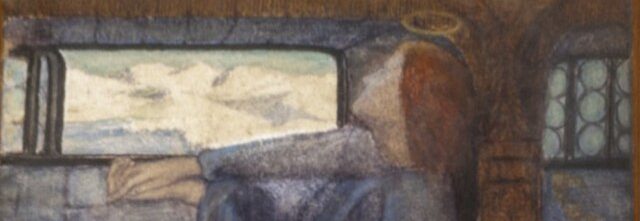Not just a muse: Elizabeth Siddal’s forgotten work
If you Google ‘Pre-Raphaelite paintings’ right now, then you’ll most likely see mystical and medieval inspired works that include a pale lady with red hair. This woman is Elizabeth Siddal, and if it isn’t her, then it is based on her. By her death in 1862, she became the symbol for Pre-Raphaelite beauty and inspired many artists, years after her death.
The Pre-Raphaelite Brotherhood was formed in 1848 of initially only seven men, including the household names of Dante Gabriel Rossetti, John Everet Millais and William Holman Hunt. The basic premise of the group was to reject the artistic teaching of the Royal Academy and formed a new perspective that was more focused on being true to nature. Their anti-academic programme involved painting with much brighter paints, painting an extra white layer onto their canvases to get the most of out their pigments, and also started the new trend of painting outside so one could work directly from nature. After the major cleaning of the paintings at the National Gallery from the Old Masters in the 1840s, there was a widespread shock at how bright the Renaissance paintings actually were. This partly inspired the group’s artistic dogma.
You may have noticed her in Millais’s ‘Ophelia’ at the Tate Britain, where she famously stayed in the cold bathtub for hours on end, nearly killing her. As traumatic as this was, she stayed committed to the arts
Siddal became involved with the brotherhood in 1849 when the painter, Walter Deverell, saw her at work. This changed Siddal’s life forever, from that day she modelled for many Pre-Raphaelite artists. This was significant for a woman of the 19th century, as being a model was equal in status to a prostitute. However, Siddal was part of some prolific works. You may have noticed her in Millais’s ‘Ophelia’ at the Tate Britain, where she famously stayed in the cold bathtub for hours on end, nearly killing her. As traumatic as this was, she stayed committed to the arts.
Even today, women involved in the Pre-Raphaelite Brotherhood have been disregarded as simply copycats of their male colleagues, with no originality
However, in the early 1850s she met Dante Rossetti who changed her life forever. Rossetti was bewitched by Siddal. After modelling for his paintings for many years, this arrangement eventually turned into a romantic relationship. This is what Siddal is mostly known for in history: being strung along by Rossetti for 10 years while her own works of art and poetry have gone largely unnoticed for nearly 200 years. This article aims to change that, so by the time you’ve read this you will know about Elizabeth Siddal and her innovative artistic creations. Whilst Siddal’s achievements are her own, she was initially encouraged by Rossetti to develop her potential in writing and painting, which was a rare experience for a woman of that period. Even today, women involved in the Pre-Raphaelite Brotherhood have been disregarded as simply copycats of their male colleagues, with no originality.
The harsh lines in this work exude a seriousness that contrasts how women were usually depicted in art
The works of Siddal naturally reflect the techniques and motifs of the Brotherhood, only more personal and intimate, giving the viewer a window into her mind. She dealt with many obstacles in her life: besides being a woman artist, she suffered from chronic pain that resulted in a laudanum addiction, uncovered Rossetti’s affair and had a still born baby. It doesn’t come as a surprise that she might’ve used her art as an outlet for her emotions, finding comfort in tales and poems that reminded her that she wasn’t alone in her pain. One of her many paintings is ‘St Agnes’ Eve’, 1853-60, depicting a nun gazing out a window while contemplating her choices before she commits to God. Siddal’s works have a common theme of entrapment and often depict the subject reaching out to something, possibly reflecting her inability to achieve on the same level as her male counterparts. Another example of her work is ‘Lady of Shalott’. Her art was usually based on medieval themes or folklore (she would’ve loved Pinterest). ‘Lady of Shalott’ can be argued to be a self-portrait of Siddal, emphasising her struggle of separating the art from the artist. Once again, the painting shows a lady, trapped and tied to her interior space, reflecting how difficult it is for a young female artist to reach the art market. The harsh lines in this work exude a seriousness that contrasts how women were usually depicted in art. Images of women artists were seen as satire because they simply dabbled: they of course could never be professionals, unlike men. Even though women of this period faced much criticism, it is clear to see that Siddal developed a unique style that was original to the Brotherhood. This might be because she wasn’t professionally trained, using the exclusion of women to her advantage. Her work was ultimately exhibited at the summer exhibition at Russell Place in 1857.
Unfortunately, we only have 10 year’s worth of art from Siddal, as she died at the age of 32 by a laudanum overdose. But, the work that she created is priceless and important, not only to the art world, but to amending the narrative of 19th century society.

Comments